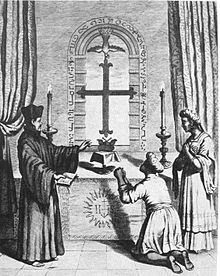Thomas the Apostle
Thomas the Apostle (called Didymus which means "the twin") was one of theTwelve Apostles of Jesus Christ, according to the New Testament. He is informally called doubting Thomas because he doubted Jesus' resurrection when first told (in the Gospel of John), followed later by his confession of faith, "My Lord and my God", on seeing Jesus' wounded body.
Traditionally, he is said to have travelled outside the Roman Empire to preach the Gospel, travelling as far as Tamilakam in present-day India.[2][5][6][7] According to tradition, the Apostle reached Muziris, Tamilakam present day India in AD 52 and baptized several people, founding what today are known as Saint Thomas Christiansor Nasranis. After his death, the reputed relics of Saint Thomas the Apostle were enshrined as far as Mesopotamia in the 3rd century, and later moved to various places.[8] In 1258, some of the relics were brought to Abruzzo in Ortona, Italy, where they have been held in the Church of Saint Thomas the Apostle.[9] He is often regarded as the Patron Saint of India,[10][11] and the name Thoma remains quite popular among Saint Thomas Christians of India.
Mission in India[edit]
Main articles: Saint Thomas Christians and Christianity in India
Thomas is traditionally believed to have sailed to India in AD 52 to spread the Christian faith, and is believed to have landed at the port of Muziris, Tamilakam (modern-day North Paravur and Kodungalloor in modern-day Kerala state) where there was a Jewish community at the time.[2][5] The port was destroyed in 1341 due to a massive flood that realigned the coasts. He is believed by the St Thomas Christian tradition to have established Ezharappallikal or Seven and Half Churches in Kerala. These churches are at Kodungallur, Palayoor, Kottakkavu (Paravur), Kokkamangalam, Niranam, Nilackal (Chayal),Kollam and Thiruvithamcode (half church).[28]
It was to a land of dark people he was sent, to clothe them by Baptism in white robes. His grateful dawn dispelled India's painful darkness. It was his mission to espouse India to the One-Begotten. The merchant is blessed for having so great a treasure. Edessa thus became the blessed city by possessing the greatest pearl India could yield. Thomas works miracles in India, and at Edessa Thomas is destined to baptize peoples perverse and steeped in darkness, and that in the land of India.
Death[edit]
According to tradition, St. Thomas was killed at Mylapore, near Chennai, in 72 and his body was interred there.[32] Ephrem the Syrian states that the Apostle was martyred in India, and that his relics were taken then to Edessa. This is the earliest known record of his martyrdom.[33]
The accounts of Marco Polo from the 13th century state that the Apostle had an accidental death outside his hermitage in Chennai by a badly aimed arrow of a fowler who not seeing the saint shot at peacocks there.[34]:238 Since at least the 16th century, the St. Thomas Mount has been a common site revered by Hindus, Muslims and Christians.[34]:31 The records of Barbosa from early 16th century inform that the tomb was then maintained by a Muslim who kept a lamp burning there.[34]:237 TheSan Thome Basilica Mylapore, Chennai, Tamil Nadu, India presently located at the tomb was first built in the 16th century and rebuilt in the 19th.[35]
Mylapore, Chennai, Tamil Nadu, India[edit]
St. Thomas arrived in Southern India - Tamilakam - in the present day Indian state ofKerala and a few relics are still kept at San Thome Basilica in Chennai, Mylapore, India. Marco Polo, the Venetian traveller and author of Description of the World,popularly known as Il Milione, is reputed to have visited Southern India in 1288 and 1292. The first date has been rejected as he was in China at the time, but the second date is accepted by many historians.[citation needed] He also stopped at Quilon (Kollam) on the western Malabar coast of India, where he met Syrian Christians and recorded their tradition of St. Thomas and his tomb on the eastern Coromandel coast of the country. Il Milione, the book he dictated on his return to Europe, was on its publication condemned by the Church as a collection of impious and improbable traveller's tales. It became very popular reading in medieval Europe and inspired Spanish and Portuguese sailors to seek out the fabulous (and possibly Christian) India described in it.
source ... https://en.wikipedia.org/wiki/Thomas_the_Apostle













Comments
Post a Comment